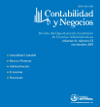Contabilidad de cobertura: ¿formalidad para evitar asimetrías o principio de correlación?
DOI:
https://doi.org/10.18800/contabilidad.201902.001Palabras clave:
Cobertura de riesgos financieros, NIIF, Correlación y simetría contableResumen
Este trabajo de investigación tiene como objetivo analizar en qué consiste la contabilidad de cobertura, partiendo del Marco Conceptual para la información financiera emitido por IASB y, principalmente, sobre cómo es su reconocimiento en los estados financieros. El análisis se hará sobre la base de lo que establece la NIC 39, que es la norma vigente hasta el 31 de diciembre del 2017. También se evidenciarán las principales diferencias con la NIIF 9, que entró en vigencia a partir del 1 de enero del 2018. Cabe aclarar que, si bien la NIIF 9 ha entrado en vigencia, el mismo estándar establece que las empresas podrán usar según su preferencia la contabilidad de cobertura que está en la NIC 39 o en la NIIF 9; es decir, la NIC 39 aún sigue vigente en lo que se refiere a la contabilidad de cobertura. En este trabajo, también se indicarán las tres posiciones que existen con respecto a la contabilidad de cobertura, así como el sustento de cada posición. Además, cuando sea pertinente, se hará referencia a los US GAAP (United States Generally Accepted Accounting Principles, que son principios de contabilidad generalmente aceptados en los Estados Unidos), contenidas en las ASC (Accounting Standard Codification). El modelo de los US GAAP con respecto al reconocimiento de la contabilidad de cobertura es muy similar al modelo de las IFRS (International Financial Reporting Standard o Normas Internacionales de Información Financiera). Finalmente, se presentarán las principales conclusiones de este trabajo de investigación.











